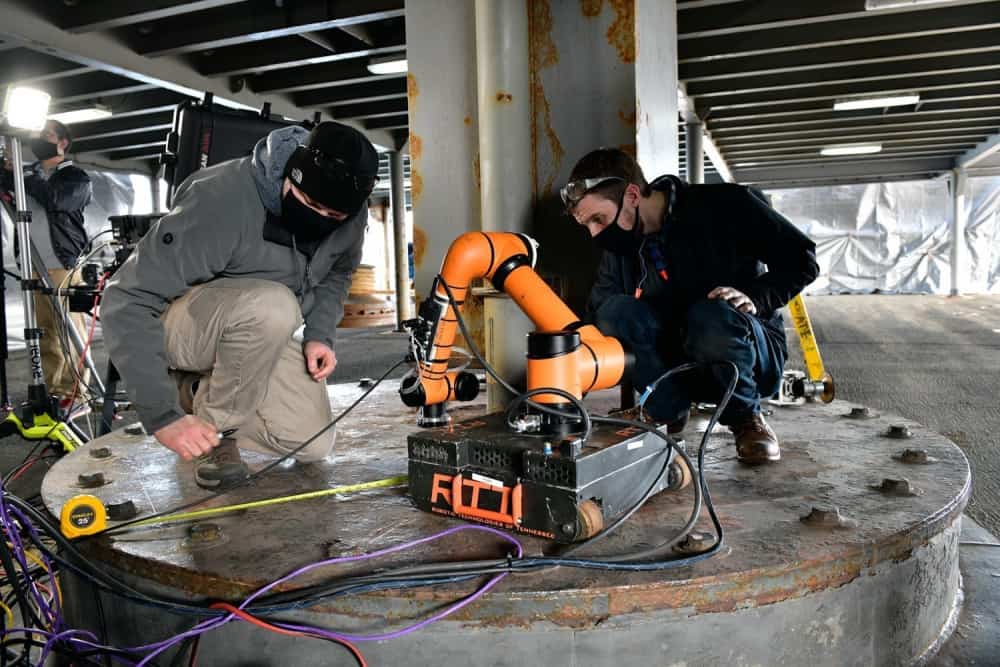
Image: Penn State ARL
Penn State’s Applied Research Lab (ARL) and the Naval Sea Systems Command Technology Office (NAVSEA 05T), along with NAVSEA warfare centers, are pioneering a portable robot and a user-friendly operating system to automate ship repair for the Navy.
The NAVSEA 05T-sponsored Multifunctional Automated Repair System (MARS) project aims to use the robot to do certain maintenance and repair tasks aboard Navy ships like surface restoration, laser scanning, grinding, paint removal, cold-spraying and ultrasonic and electromagnetic Eddy Current inspection methods. The MARS will modernize maintenance with new technology designed for next-generation recruits who are educated in traditional trades and with Industry-4.0 type methods.”
“MARS will provide an automated portable system with surface preparation, repair and inspection methods for current and emergent facilities including forward-operating bases, ships and maintenance activities at shipyards,” said Carlos Boisselier, NSWC PHD’s Self Defense Test Ship systems engineer said in an article on Military Spot. Advantages of the robot include faster maintenance of ships and a new training aid for sailors, according to project members.
Recently, Penn State and NAVSEA 05T engineers spent three days live-testing and demonstrating a prototype robot and its capabilities on NSWC PHD’s Self Defense Test Ship, getting valuable feedback from Navy sailors on modifications that would improve the robot’s performance and ease-of-use. They also sought direction on tasks that the robot could perform from warfare centers’ engineers and experts; and warfare center activities will likely expand over time.
“We hope our workforce will be more willing to stay, and we’ll attract a new user—a next-generation mechanic or artisan—who learns traditional trades but with modern industry-4.0 type methods.”
In 2018, the U.S. Navy awarded the ARL the largest research contract in Penn State’s history – worth as much as $2.1 billion over 10 years – to conduct research and development to improve U.S. national security. It’s one of 14 Department of Defense (DoD) University Affiliated Research Center (UARC) laboratories that have long-term strategic relationships with the DoD and are considered trusted agents. These affiliated research centers provide essential research capabilities, develop new technology for national security applications, and provide unbiased technical advice to the DoD and other federal agencies.
Making of a prototype: from pencil sketch to video game controllers
MARS is just the latest example of how ARL provides research and innovation for the Navy. The project began when Tim Eden, head of the materials processing division at ARL, and Janice Bryant, NAVSEA 05T’s strategic technology manager and program manager for the project penciled out the concept of the MARS on the back of an 8½-inch by 11-inch piece of paper in 2020 after discussing the Navy’s sustainment and repair needs.
Bryant said that she initially envisioned the robot expanding Navy sailors’ skills to include operating a robot as well as giving them more resources to conduct their everyday jobs and reduce the amount of manual labor.
“I’m hoping that the MARS helps boost our personnel retention rate as we learn how to modernize maintenance with some of the new technology,” Bryant said. “We hope our workforce will be more willing to stay, and we’ll attract a new user—a next-generation mechanic or artisan—who learns traditional trades but with modern industry-4.0 type methods.”
As the project progressed, ARL engineers worked to make operating the robot more user-friendly for sailors. They modified a video game controller and connected it to the robot’s interface so the sailor can direct the robot’s movements easily.
“It’s a stepping stone for the workforce, seeing what’s within the arc of the possible, and helping us to think bigger and start considering alternative solutions to some of the challenges facing the Navy’s maintenance and repair community.”
“One of our other engineers who works at the Electro-Optics Center, which is part of the Applied Research Lab, and his team completely gutted and redesigned the software for this system to make a new user interface with the video game controller so it’s intuitive for the sailor to use, which is something that was missing from the previous version of the system,” says Anthony Naccarelli, research and development engineer for Penn State.
Along with the robot’s easy interface for the sailors and a personalized and condensed training program, learning how to operate the new robotics system will provide sailors with opportunities for training on different topics—ultimately increasing their value to the fleet and Navy.
“There are a few different advantages,” Eden said. “One is the right training. You can have four or five different training modules and have a sailor who can perform five different operations using the robot, so you wouldn’t have to train five different people on those tasks. The sailors wouldn’t need to be experts in those areas, so they would perform the operations faster because one sailor could do five different jobs.”
Finding solutions through the iterative process
The program’s long-term vision is to make the robot and various components easy to transport to multiple ships where they are needed. The NAVSEA 05T and Penn State team envision utilizing a 20-foot Conex container that has everything the sailors would need to set up and operate the robot, according to Naccarelli.
After demonstrating the robot system with NSWC PHD’s Self Defense Test Ship and its crew, Janice Bryant was happy with the feedback, and said the crew’s expertise will significantly contribute to the robot’s development as the project continues to grow and adapt to the needs of the Navy and the warfighter.
“I’ve been so amazed at the skill and expertise of everyone on this vessel; they have lots of years of maintenance experience, so it’s thrilling to talk to them and hear where they’ve been and what they’re doing,” Bryant explained. “You’ve got a whole bevy of unsung heroes here with such passion for what they’re doing, and the knowledge is just unreal. It’s a great place to learn from them.”
David Aaron, product support office fleet supportability manager for NSWC PHD, said this project could help the Navy tap into technology in a new way to solve problems sailors are regularly faced with, and he is eager to see its outcome.
“It’s exciting to see these kinds of tools and capabilities starting to come into fruition through an iterative development approach,” Aaron said. “It’s a stepping stone for the workforce, seeing what’s within the arc of the possible, and helping us to think bigger and start considering alternative solutions to some of the challenges facing the Navy’s maintenance and repair community.”






